Loudoun Emergency Warning Sirens: Difference between revisions
No edit summary |
No edit summary |
||
| Line 25: | Line 25: | ||
</ref> The poster has been contacted and is in the process of trying to find the document; until it's found, the Model "ES-3000" remains unconfirmed. Absolutely nothing is known about these, and there is very little evidence to support their existence apart from the supposed FEMA document, aside from the jump from "2000" to "4000" being slightly unusual otherwise. It is unknown what this siren looks like, but it would most likely share the same head as the Model ES-2000. | </ref> The poster has been contacted and is in the process of trying to find the document; until it's found, the Model "ES-3000" remains unconfirmed. Absolutely nothing is known about these, and there is very little evidence to support their existence apart from the supposed FEMA document, aside from the jump from "2000" to "4000" being slightly unusual otherwise. It is unknown what this siren looks like, but it would most likely share the same head as the Model ES-2000. | ||
=== Model ES-4000 === | === Model ES-4000 === | ||
[[File:Loudoun ES-4000.jpg|thumb|160x160px|Two Loudoun ES-4000 units at Loudoun's facility in 2012. Photo by Loudoun Communications.]]The '''Model ES-4000''' superseded the Model ES-2000 sometime before or during 2008 and enjoyed the most successful run out of all of Loudoun's previous sirens. The Model ES-2000 was a further improvement of the Model ES-2000, and both are similar though there a few key differences between the 2 sirens. The siren heads used are both relatively identical; they utilize 8 100 W Sanming Sound SD-210R drivers (with 2 drivers sharing a throat for each horn), pushing the total wattage up to | [[File:Loudoun ES-4000.jpg|thumb|160x160px|Two Loudoun ES-4000 units at Loudoun's facility in 2012. Photo by Loudoun Communications.]]The '''Model ES-4000''' superseded the Model ES-2000 sometime before or during 2008 and enjoyed the most successful run out of all of Loudoun's previous sirens. The Model ES-2000 was a further improvement of the Model ES-2000, and both are similar though there a few key differences between the 2 sirens. The siren heads used are both relatively identical; they utilize 8 100 W Sanming Sound SD-210R drivers (with 2 drivers sharing a throat for each horn), pushing the total wattage up to 800 W. The drivers are enclosed in an octagonal enclosure made of fiberglass which improves their longevity. A service door is built into the side, providing relatively easy maintenance to the drivers. An eyebolt tops the enclosure for ease of installation. The exact proportions of the octagon shape are irregular and can vary by unit, evident by the siren's horns appearing closer or farther apart depending on the size of the enclosure. The siren utilizes large circular DR-72 horns, although they are very unidirectional and form a clover-shaped area of coverage that results in off-axis gaps in areas between each horn. All Model ES-4000 horns have AtlasIED "A" stickers on the tip of the throats. The entire assembly is mounted to a pole via 4 L-brackets connected to the base of the driver housing; the brackets are quite small and on rare occasions fail to hold the assembly above it during high winds or an impact from debris, leading to the siren head essentially dangling off the pole. | ||
The differences between the Model ES-4000 and its predecessor lie within the controllers; most of the exact components the Model ES-4000 utilizes are unknown, aside from the fact that they are analog and use AC QSC amplifiers, although the difference can be noticed both visually and audibly. Model ES-4000 controllers are stainless steel, cubical, and have 2 support beams which are bolted to the pole and extend to the base of the enclosure. These controllers began to circulate by 2010 and superseded an earlier iteration that shared the same enclosure as the Model ES-2000 controller; early Model ES-4000s are essentially identical to ES-2000s because of this. Some Model ES-4000s also have decals on their control boxes, which all read "'''MASTER BLASTER ES4000'''" and have the phone number of Loudoun Communications placed near the bottom of the cabinet door. Model ES-4000 sirens in Caroll County, KY, installed by J&N Electronics, a partner of Loudoun, have slightly altered decals reading "'''MASTER BLASTER ES4000 J&N ELECTRONICS'''", alongside the phone number of J&N Electronics and the unit number. The newer J&N Model ES-4000s with cubical control cabinets also have these decals, although in a rearranged order. Loudoun/J&N is responsible for all of the decal work in-house prior to shipment and the decals are customized for the contractor/customer upon request. This practice seemed to have ceased by the introduction of the Model ES-5000DC. | The differences between the Model ES-4000 and its predecessor lie within the controllers; most of the exact components the Model ES-4000 utilizes are unknown, aside from the fact that they are analog and use AC QSC amplifiers, although the difference can be noticed both visually and audibly. Model ES-4000 controllers are stainless steel, cubical, and have 2 support beams which are bolted to the pole and extend to the base of the enclosure. These controllers began to circulate by 2010 and superseded an earlier iteration that shared the same enclosure as the Model ES-2000 controller; early Model ES-4000s are essentially identical to ES-2000s because of this. Some Model ES-4000s also have decals on their control boxes, which all read "'''MASTER BLASTER ES4000'''" and have the phone number of Loudoun Communications placed near the bottom of the cabinet door. Model ES-4000 sirens in Caroll County, KY, installed by J&N Electronics, a partner of Loudoun, have slightly altered decals reading "'''MASTER BLASTER ES4000 J&N ELECTRONICS'''", alongside the phone number of J&N Electronics and the unit number. The newer J&N Model ES-4000s with cubical control cabinets also have these decals, although in a rearranged order. Loudoun/J&N is responsible for all of the decal work in-house prior to shipment and the decals are customized for the contractor/customer upon request. This practice seemed to have ceased by the introduction of the Model ES-5000DC. | ||
Revision as of 17:47, 23 October 2024
| Loudoun Emergency Warning Sirens
Loudoun Master Blaster | |
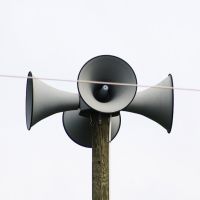 A Model ES-2000, located in Reynolds, GA. | |
| Company | Loudoun Communications |
|---|---|
| Produced | ≥1978?-present |
| Type | Directional Electronic |
| Sound output | 115 dB @ 100 ft (Model ES-4000) |
| Wattage | 375-500 W (CJ-46 siren)
1200 W (Model ES-2000 onwards) |
| Voltage | 12 V DC (controller, Model ES-2000)
120 V AC (amplifier, Model ES-2000)
24 V DC (Model ES-4000 onwards) |
| Documentation | Product sheet |
Loudoun's Emergency Warning Sirens, also marketed as Master Blaster (also written MasterBlaster or Masterblaster), are a "specialty equipment" line of omnidirectional electronic sirens made by Loudoun Communications, a Douglasville, GA-based business specializing in radios and related equipment. Loudoun sirens can primarily be found in the state of Georgia and compete regionally with Federal Signal and Whelen Engineering.
History and Design
CJ-46 siren (Model "ES-1000")
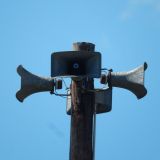
Before Loudoun finalized their designs, they sold a siren which utilized black rectangular paging horns and lacks a known model name. These are often referred to as "black array Loudouns" or "ES-1000"s (the latter being derived from pure speculation and having no evidence supporting its existence, though supposed documents detailing a FEMA grant to Newton County, GA make mention of the aforementioned name as well as an "ES-3000"). Although little to nothing is known about these, they were most likely a product of Loudoun, as they utilize controllers which would later be seen on the Model ES-2000. Loudoun themselves however claim that they either never produced these sirens or do not remember making them. All of these sirens share the same basic and relatively unprofessional setup, consisting of 4 speaker drivers of varying manufacturer (which are unprotected from the elements) attached to Atlas CJ-46 paging horns mounted to a pole, sometimes at a slightly skewed angle. 3 speaker units were also available. A handful of these, which are either later units of these sirens or early Model ES-2000 units, utilize DR-72 horns, which would later be carried over to the ES-2000. Proper brackets for these sirens were not supplied, leading to some units have very irregular mounting configurations, as is the case for many of the water tower mounted units in Newton County.
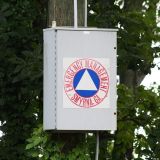
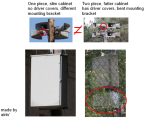
The sirens are hooked up to a basic early 12 V DC (assuming that these run on the same controllers as the Model ES-2000) analog controller, which is able to perform the standard Steady and Up/Down tones. The siren's amplifier runs on 120 V AC however, making it incapable of running solely on batteries. The controls used on these units seem to be similar to those used on Model ES-2000s, although there are slight differences in terms of the enclosures and the pitch on the CJ-46 sirens peaks considerably higher compared to later models. These do not exist outside of Georgia, suggesting that they were most likely produced post-1978, when Loudoun relocated their operations to Douglasville; Pole tags suggest that most of these sirens were produced between the late 1970s and mid 1980s. These sirens are commonly described as exceptionally quiet, though this may simply be due to the controllers wearing out; one particular unit in rural Covington, GA was reported to the Newton County EMA for this suspected issue and was described as considerably louder in a recording following its repair[1], although what exactly this repair consisted of and what the problem was to begin with was unclear. These sirens are often confused with Whelen WS-1000s for their similar appearance at first glance; they share several key differences, such as their control enclosures and driver covers, or lack thereof.
Model ES-2000
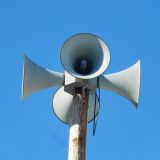
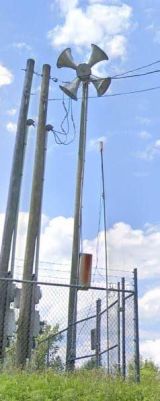
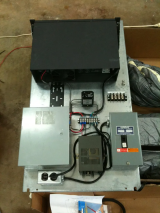
The Model ES-2000, introduced sometime either in the late 1990s or early 2000s, would pave the way for the designs of Loudoun's sirens going forward and would right many of the CJ-46 siren's wrongs. The Model ES-2000 utilizes 8 100 W drivers (with 2 drivers sharing a throat for each horn), pushing the total wattage up to 800 W. The drivers are enclosed in an octagonal enclosure made of fiberglass which improves their longevity. A service door is built into the side, providing relatively easy maintenance to the drivers. An eyebolt tops the enclosure for ease of installation. The exact proportions of the octagon shape are irregular and can vary by unit, evident by the siren's horns appearing closer or farther apart depending on the size of the enclosure. The CJ-46 horns used on the previous Loudoun siren would be swapped out with larger circular DR-72 horns for the Model ES-2000, likely boosting its output and range. These horns are very unidirectional and form a clover-shaped area of coverage that results in off-axis gaps in areas between each horn. Older units' horns' have an Atlas Soundolier sticker on the tip of the throats, while newer ones simply have an AtlasIED "A" sticker.
The entire assembly is mounted to a pole via 4 L-brackets connected to the base of the driver housing; the brackets are quite small and on rare occasions fail to hold the assembly above it during high winds or an impact from debris, leading to the siren head essentially dangling off the pole. The Model ES-2000 utilizes the same analog controller seen on the CJ-46 sirens, with little to no differences observed between the 2, aside from peaking at a lower pitch. The Model ES-2000 cabinets are also far more prone to rusting, which in some cases results in issues with the siren itself, as has been documented in Henry County, GA. Like its predecessor, while the controller runs on 12 V DC, the amplifier runs on 120 V AC, also making it incapable of running solely on batteries. The Model ES-2000, compared to its predecessor, sold many more units, with Newton County and the aforementioned Henry County being a few examples of communities utilizing a large system of them among others. It is unknown when the Model ES-2000 ended production; it is not mentioned on the small amount of WayBack Machine archives of Loudoun's website before the late 2010s, and the potential of the Model "ES-3000" existing only adds to the confusion. At the very latest, discrediting the Model "ES-3000"', it was sold up no later than 2008, which marked the first mention of the Model ES-4000 on Loudoun's website.
Model "ES-3000"
The Model "ES-3000" is a siren which was purportedly sold by Loudoun for an unknown period of time. According to an alleged document detailing a FEMA grant, at least a handful of these were installed, alongside "ES-1000"s, particularly one in Covington, Georgia. The source for this comes from a Facebook comment under a discussion about a theorized "ES-1000" in Newton County. </ref> The poster has been contacted and is in the process of trying to find the document; until it's found, the Model "ES-3000" remains unconfirmed. Absolutely nothing is known about these, and there is very little evidence to support their existence apart from the supposed FEMA document, aside from the jump from "2000" to "4000" being slightly unusual otherwise. It is unknown what this siren looks like, but it would most likely share the same head as the Model ES-2000.
Model ES-4000
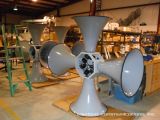
The Model ES-4000 superseded the Model ES-2000 sometime before or during 2008 and enjoyed the most successful run out of all of Loudoun's previous sirens. The Model ES-2000 was a further improvement of the Model ES-2000, and both are similar though there a few key differences between the 2 sirens. The siren heads used are both relatively identical; they utilize 8 100 W Sanming Sound SD-210R drivers (with 2 drivers sharing a throat for each horn), pushing the total wattage up to 800 W. The drivers are enclosed in an octagonal enclosure made of fiberglass which improves their longevity. A service door is built into the side, providing relatively easy maintenance to the drivers. An eyebolt tops the enclosure for ease of installation. The exact proportions of the octagon shape are irregular and can vary by unit, evident by the siren's horns appearing closer or farther apart depending on the size of the enclosure. The siren utilizes large circular DR-72 horns, although they are very unidirectional and form a clover-shaped area of coverage that results in off-axis gaps in areas between each horn. All Model ES-4000 horns have AtlasIED "A" stickers on the tip of the throats. The entire assembly is mounted to a pole via 4 L-brackets connected to the base of the driver housing; the brackets are quite small and on rare occasions fail to hold the assembly above it during high winds or an impact from debris, leading to the siren head essentially dangling off the pole.
The differences between the Model ES-4000 and its predecessor lie within the controllers; most of the exact components the Model ES-4000 utilizes are unknown, aside from the fact that they are analog and use AC QSC amplifiers, although the difference can be noticed both visually and audibly. Model ES-4000 controllers are stainless steel, cubical, and have 2 support beams which are bolted to the pole and extend to the base of the enclosure. These controllers began to circulate by 2010 and superseded an earlier iteration that shared the same enclosure as the Model ES-2000 controller; early Model ES-4000s are essentially identical to ES-2000s because of this. Some Model ES-4000s also have decals on their control boxes, which all read "MASTER BLASTER ES4000" and have the phone number of Loudoun Communications placed near the bottom of the cabinet door. Model ES-4000 sirens in Caroll County, KY, installed by J&N Electronics, a partner of Loudoun, have slightly altered decals reading "MASTER BLASTER ES4000 J&N ELECTRONICS", alongside the phone number of J&N Electronics and the unit number. The newer J&N Model ES-4000s with cubical control cabinets also have these decals, although in a rearranged order. Loudoun/J&N is responsible for all of the decal work in-house prior to shipment and the decals are customized for the contractor/customer upon request. This practice seemed to have ceased by the introduction of the Model ES-5000DC.
WIP
Model ES-5000DC
WIP